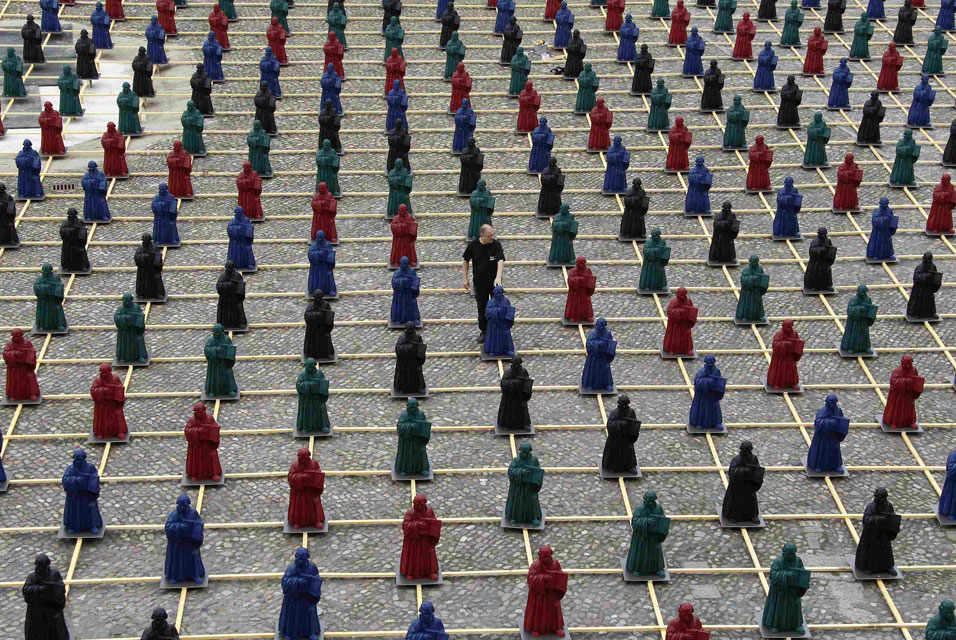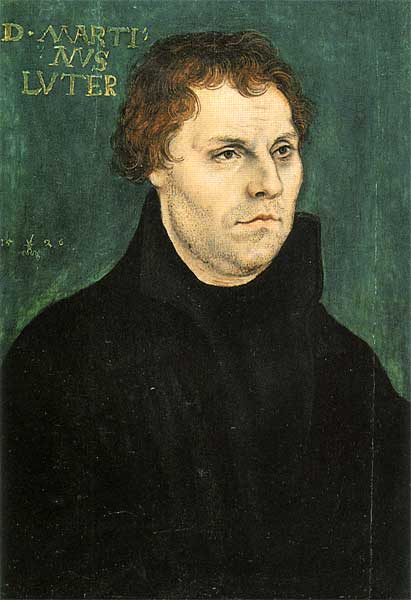Martin Luther is still creating controversy. Recently, about 800 statuettes of the 16th-century Protestant reformer popped up in the eastern German town of Wittenberg, where Luther first preached against practices of the Roman Catholic church almost five hundred years ago. The three-foot plastic figurines, garden ornament style in four colors were created by Ottmar Hoerl, who caused controversy in 2009 with 1,250 garden gnomes with arms outstretched in a Nazi salute.

---German artist Ottmar Hoerl’s just concluded art project named “Martin Luther: Here I stand...”, held in the market square of the East German town of Wittenberg, had all of 800 one meter high colorful plastic statues of the 16th Century Protestant reformer Martin Luther, identical to the one made by Gottfried Schadow in1821 that normally stands on the square. The ‘Here I stand’ part is probably a reference to the last sentence of a speech given by Luther after a legislative assembly reacted to his writings on reforming the Catholic Church. Several theologians have taken umbrage at this display of ‘dwarf Luthers’... Read More:http://www.newsvision.in/luxelivingmay/luxelivingsep/luxeliving_augmain.htm image:http://www.artdaily.com/index.asp?int_sec=11&int_new=39891&int_modo=2
The current Luther’s on the town square were intended to replace a statue of Martin Luther that is being renovated. Evidently, some Protestant theologians were less than amused, calling the statuettes a mockery of Luther’s achievements. Yet, going back 500 years, it all seemed to begin so simply and with such great promise.Who would have thought of a religious war could happen? A hundred years later Germany’s burbling and fragmented political situation would turn a local German struggle into a European wide conflict using Germany as its battleground in the Thirty-Years War beginning in 1618.

Pope Leo X succeeded Julius II on his death, he was a member of the Medici family and continued to act as patron to the artist. Raphael painted the Pope's portrait in 1518. In Raphael's portrait, a myopic Leo X holds the magnifying glass he always kept at hand. His nephew, the future Clement VII, is at left. image:http://www.italian-renaissance-art.com/Raphael.html
“God has given us the Papacy, now let us enjoy it.” The words may never have been spoken , but they are unforgettable. History will forever remember Leo X as the pope who presided in cultured splendor over the dissolution of the medieval Catholic Church. Time has not been kind to Giovanni de’ Medici, whose family purchased him a cardinal’s hat at fourteen and who was elected pope in 1513 at the age of thirty-seven. His own generation, however, applauded the elevation of a restful and generous man of exquisite taste and powerful connections who would “act as a gentle lamb rather than a fierce lion” and would promote peace not war.
Yet, it is Leo and not his less savory predecessors – Innocent VIII, Alexander VI, and Julius II, who is remembered as the pope who fiddled while Christendom went up in flames. The avarice, perversion, and heavy fisted aggression of these predecessors are scarcely recalled, but the frivolousness of a highly intelligent man who refused to take Martin Luther seriously has never been forgiven or forgotten.

---Supporters of Lucas Cranach the Elder (c. 1472-1553) regard him as one of the most important artists of the German Renaissance, but he has had his fair share of critics. Richard Dorment of the Daily Telegraph recently said: "If we judged works of art… giving points for draughtsmanship, composition, handling of pictorial space and grasp of anatomy – then the paintings of Lucas Cranach wouldn't win any blue ribbons"....He is also known for his distinctive portraits. Cranach was a lifelong friend of Martin Luther (1483-1546) of whom he produced several portraits. The Portrait of Luther shown here was painted in 1525. Cranach also designed woodcuts for Luther's translation of the New Testament and painted many alter pieces for Lutheran churches. Read More:http://www.suite101.com/content/lucas-cranach-the-elder-a46920 image:http://www.wikipaintings.org/en/lucas-cranach-the-elder/martin-luther-1526
Leo epitomized the spiritual sterility that was spreading throughout the old church; the entire hierarchy from local priest to pope could not sense the intensity of despair, love, faith and hate that made it impossible for some men to countenance life with its multitude of petty abuses and sordid secular ways. They were what William James called “healthy-minded men” in matters of religion, men who never found cause to ask : what am I doing in an eternity of space and time? His was the generation of the intellectual intoxication of the eternal city.
There is something disturbing about the character of the Renaissance pope. Its the unsettling ambivalence: the gastronomic orgies while he ate sparingly, the generosity to art and scholarship yet he condoned the cruelest kind of buffoonery and permitted the ridicule of poets who had been deliberately led to believe they were geniuses.
Leo was a man who was chaste in his private life, but who financed an elaborate and public verse play in 1521 during the Spring Carnival in which a woman prayed to Venus to send her a lover and was obliged with eight hermits who conveniently turned into robust young men and fought one another to the death for her charms, the sole survivor receiving the prize. He is also said to have dismissed one of the stories of Christ’s life as “a profitable fable” . He is said to have gilded reality with a veneer of art, learning and diplomacy and to live life, as it were, vicariously. But, he presided over an institution that spoke for the heart and soul of Christendom, but was emotionally dead to the desire that stands at the core of the Christian’s response to God.
It is one of the most tragic ironies of history that such a pope should
e been called upon to handle one of the lustiest Christians of all times: Martin Luther.ADDENDUM:
Fear of religious subversion caused rulers to monitor the conduct of their subjects more closely. Attempting to help the modern reader understand the intensity and pervasiveness of this fear, Mary Fulbrook, a noted British historian of Germany, has likened it to the anxiety prevailing in the first years of the Cold War. An example of the social paranoia engendered by the religious tensions of the period is Protestant Germany’s refusal until 1700 to accept the Gregorian calendar introduced by the papacy in 1582 because the reform entailed a one-time loss of the days between October 5 and 14. Many Protestants suspected that Roman Catholics were attempting somehow to steal this time for themselves. Read More:http://www.mongabay.com/history/germany/germany-the_counter-reformation_and_religious_tensions_the_thirty_years%27_war,_1618-48.html





 COMMENTS
COMMENTS